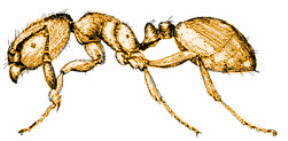
Thomas Say first described this species under the name Myrmica molesta. After giving an anatomical account, including a length measurement of "less than three-twentieths of an inch," Say writes more colloquially:
This is called the "little yellow ant," and is frequently found in houses in great numbers. They sometimes eat vegetable food, and some of my garden seeds have severely suffered from their attacks. They also devour grease, olive oil, etc. Their sting is like the puncture of a very fine needle. I placed a piece of meat on a window board frequented by these little depredators; it was soon absolutely covered by them, and thus enabled me to destroy thousands, every few hours that I returned to examine the bait, for several days, during which time their apparent numbers scarcely diminished.
For Say's description, see volume 2, page 737-8 of
John L. Le Conte, The Complete Writings of Thomas Say on the Entomology of North America, two volumes, Baillière Brothers, New York, 1859. Reprinted by Arno Press, New York, 1978.
The thief ant and its continuing presence in New Harmony are featured in a full page article in the Evansville Courier, October 1, 1998 (pages B1, B2). The article tells of the work of entomologist Eric McCloud, whose website has a Projects section on the thief ant.